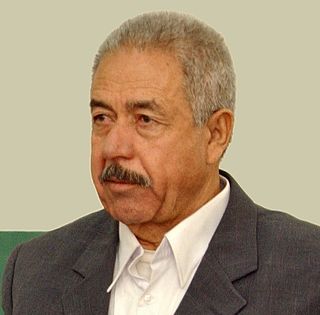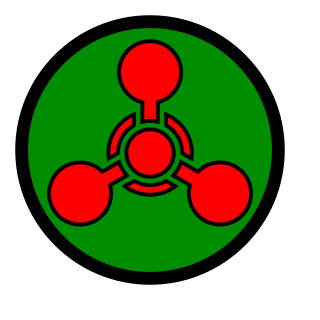Related Research Articles

A land mine, or landmine, is an explosive weapon concealed under or camouflaged on the ground, and designed to destroy or disable enemy targets, ranging from combatants to vehicles and tanks, as they pass over or near it.
Nerve agents, sometimes also called nerve gases, are a class of organic chemicals that disrupt the mechanisms by which nerves transfer messages to organs. The disruption is caused by the blocking of acetylcholinesterase (AChE), an enzyme that catalyzes the breakdown of acetylcholine, a neurotransmitter. Nerve agents are irreversible acetylcholinesterase inhibitors used as poison.

Chemical warfare (CW) involves using the toxic properties of chemical substances as weapons. This type of warfare is distinct from nuclear warfare, biological warfare and radiological warfare, which together make up CBRN, the military acronym for chemical, biological, radiological, and nuclear, all of which are considered "weapons of mass destruction" (WMDs), a term that contrasts with conventional weapons.

Sarin is an extremely toxic organophosphorus compound. A colourless, odourless liquid, it is used as a chemical weapon due to its extreme potency as a nerve agent. Exposure can be lethal even at very low concentrations, where death can occur within one to ten minutes after direct inhalation of a lethal dose, due to suffocation from respiratory paralysis, unless antidotes are quickly administered. People who absorb a non-lethal dose and do not receive immediate medical treatment may suffer permanent neurological damage.

Tabun or GA is an extremely toxic synthetic organophosphorus compound. It is a clear, colorless, and tasteless liquid with a faint fruity odor. It is classified as a nerve agent because it can fatally interfere with normal functioning of the mammalian nervous system. Its production is strictly controlled and stockpiling outlawed by the Chemical Weapons Convention of 1993. Tabun is the first of the G-series nerve agents along with GB (sarin), GD (soman) and GF (cyclosarin).

Iraq actively researched and later employed weapons of mass destruction (WMD) from 1962 to 1991, when it destroyed its chemical weapons stockpile and halted its biological and nuclear weapon programs as required by the United Nations Security Council. The fifth president of Iraq, Saddam Hussein, was internationally condemned for his use of chemical weapons against Iranian and Kurdish civilians during the Iran–Iraq War in the 1980s. Saddam pursued an extensive biological weapons program and a nuclear weapons program, though no nuclear bomb was built. After the Gulf War, the United Nations located and destroyed large quantities of Iraqi chemical weapons and related equipment and materials; Iraq ceased its chemical, biological and nuclear programs.

VX is an extremely toxic synthetic chemical compound in the organophosphorus class, specifically, a thiophosphonate. In the class of nerve agents, it was developed for military use in chemical warfare after translation of earlier discoveries of organophosphate toxicity in pesticide research. In its pure form, VX is an oily, relatively non-volatile liquid that is amber-like in colour. Because of its low volatility, VX persists in environments where it is dispersed.
The Halabja massacre, also known as the Halabja chemical attack, was a massacre of Kurdish people that took place on 16 March 1988, during the Iraqi–Kurdish conflict in the closing days of the Iran–Iraq War in Halabja, Kurdistan, Iraq. The attack was part of the Al-Anfal Campaign in Kurdistan, as well as part of the Iraqi Army's attempt to repel the Iranian Operation Zafar 7. It took place 48 hours after the capture of the town by the Iranian Army. A United Nations (UN) medical investigation concluded that mustard gas was used in the attack, along with unidentified nerve agents.
Cyclosarin or GF is an extremely toxic substance used as a chemical weapon. It is a member of the G-series family of nerve agents, a group of chemical weapons discovered and synthesized by a German team led by Gerhard Schrader. The major nerve gases are the G agents, sarin (GB), soman (GD), tabun (GA), and the V agents such as VX. The original agent, tabun, was discovered in Germany in 1936 in the process of work on organophosphorus insecticides. Next came sarin, soman and finally, cyclosarin, a product of commercial insecticide laboratories prior to World War II.

Many nations continue to research and/or stockpile chemical weapon agents despite numerous efforts to reduce or eliminate them. Most states have joined the Chemical Weapons Convention (CWC), which required the destruction of all chemical weapons by 2012. Twelve nations have declared chemical weapons production facilities and six nations have declared stockpiles of chemical weapons. All of the declared production facilities have been destroyed or converted for civilian use after the treaty went into force.
Pine Bluff Chemical Activity is a subordinate organization of the United States Army Chemical Materials Agency located at Pine Bluff Arsenal in Pine Bluff, Arkansas. The U.S. Army stored approximately twelve percent of its original chemical weapons at the Pine Bluff Arsenal since 1942. Destruction of the last chemical weapons occurred on November 12, 2010.

In violation of the Geneva Protocol of 1925, the Iraqi Army initiated two failed and one successful (1978–1991) offensive chemical weapons (CW) programs. President Saddam Hussein (1937–2006) pursued the most extensive chemical program during the Iran–Iraq War (1980–1988), when he waged chemical warfare against his foe. He also used chemicals in 1988 in the Al-Anfal Campaign against his civilian Kurdish population and during a popular uprising in the south in 1991.

The Second Battle of al-Faw (also known as the Operation Ramadan Mubarak (Blessed Ramadan), fought on 17 April 1988, was a major battle of the Iran–Iraq War. After their defeat at the First Battle of al-Faw two years earlier, the newly restructured Iraqi Army conducted a major operation to clear the Iranians out of the peninsula.
Italy provided substantial supplies to Iraq during the Iran–Iraq War. Its greatest impact, however, was financial, with the U.S. branch of the state-owned, largest bank, Banca Nazionale del Lavoro (BNL) in Italy providing several billion dollars in funding for Iraqi military procurement. Italy also was a primary supplier to the Iraqi nuclear program, although that was not of direct effect on the Iran–Iraq War.

A chemical weapon (CW) is a specialized munition that uses chemicals formulated to inflict death or harm on humans. According to the Organisation for the Prohibition of Chemical Weapons (OPCW), this can be any chemical compound intended as a weapon "or its precursor that can cause death, injury, temporary incapacitation or sensory irritation through its chemical action. Munitions or other delivery devices designed to deliver chemical weapons, whether filled or unfilled, are also considered weapons themselves."
Valsella Meccanotecnica SpA was one of Italy's largest manufacturers of land mines. The Company's headquarters initially were in Montichiari. It had two production plants in Castenedolo near Brescia, Italy. The three companies of Valsella, Tecnovar Italiana SpA, and Misar SpA together were the centre of Italian mine production.
The United States chemical weapons program began in 1917 during World War I with the creation of the U.S. Army's Gas Service Section and ended 73 years later in 1990 with the country's practical adoption of the Chemical Weapons Convention. Destruction of stockpiled chemical weapons began in 1986 and was completed on July 7, 2023. The U.S. Army Medical Research Institute of Chemical Defense (USAMRICD), at Aberdeen Proving Ground, Maryland, continues to operate.

Muthana State Establishment or Muthanna (Arabic: منشأة المثنى العامة) (also known for its code-name Project 922 and cover name State Enterprise for Pesticide Production (SEPP)) was Iraq's main chemical weapons research, development, and production facility. It is located in Saladin Governorate 40 km south west of Samarra, 140 km north west of Baghdad. This mega facility covering an area 100 km², contained three main production areas.

During the Iran–Iraq War (1980–1988), Iraq engaged in chemical warfare against Iran on multiple occasions, including more than 30 targeted attacks on Iranian civilians. The Iraqi chemical weapons program, which had been active since the 1970s, was aimed at regulated offensive use, as evidenced in the chemical attacks against Iraqi Kurds as part of the Anfal campaign in the late 1980s. The Iraqis had also utilized chemical weapons against Iranian hospitals and medical centres. According to a 2002 article in the American newspaper The Star-Ledger, 20,000 Iranian soldiers and combat medics were killed on the spot by nerve gas. As of 2002, 5,000 of the 80,000 survivors continue to seek regular medical treatment, while 1,000 are hospital inpatients. Though the use of chemical weapons in international armed conflict was banned under the Geneva Protocol, much of the international community remained indifferent to the attacks; Iraq's military campaign in Iran was supported by the United States and the Soviet Union, both of whom had sought to contain Iranian influence after the Islamic Revolution of 1979.
Chemical weapons have been a part of warfare in most societies for centuries. However, their usage has been extremely controversial since the 20th century.
References
- ↑ Barry, Roger (16 March 2006), "Quadripartite Committee Reports", Hansard (UK), archived from the original on 18 July 2010
- ↑ "Italy: Production and Transfer", Land Mine Monitor, 1999
- 1 2 Bryant, Terry (2007), History's Greatest War, eBook: Global Media, ISBN 9788189940638
- ↑ Frank, Mitch (2 February 2003), "The Inspections So Far: The Blix Scorecard", Time, archived from the original on October 23, 2012
- ↑ Timmerman, Kenneth R. (18 February 2003), "Eurobiz is caught arming Saddam; the strident opposition in some European capitals to U.S. military action against Saddam Hussein may have roots in some bottom-line corporate considerations - The world: Iraq's weapons of mass destruction", Insight on the News
- ↑ Erikson, Marc (5 February 2003), Germany's leading role in arming Iraq